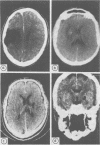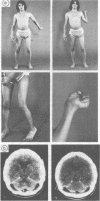Abstract
Hemidystonia defined as involuntary, sustained posturing of the unilateral arm, leg, and face was studied in 12 male and 10 female patients. Hemidystonia was caused by cerebrovascular disease in eight patients, perinatal trauma or childhood injury in four, head trauma and its sequelae in three, neuronal storage disorders in two, neurodegenerative disease in two, lesions after thalamotomy in two, and presumed encephalitis in one. Sixteen patients (73%) had CT evidence of contralateral basal ganglia damage, history of hemiparesis, or both. Brain damage before 7 years of age produced contralateral hemidystonia with a mean delay of 9-7 years. In older patients hemidystonia appeared within 6 months after injury. Hemidystonia may result from a disconnection between the striatum and the thalamus with relative preservation of the corticospinal pathways.
Full text
PDF
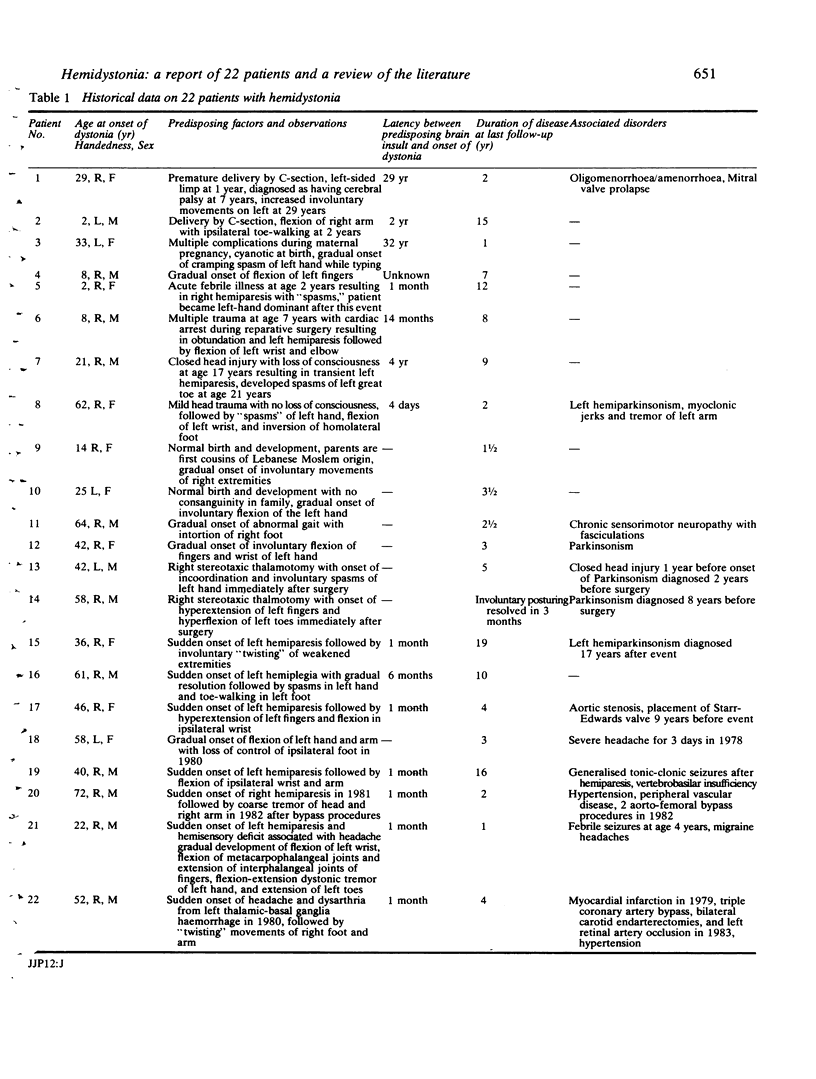
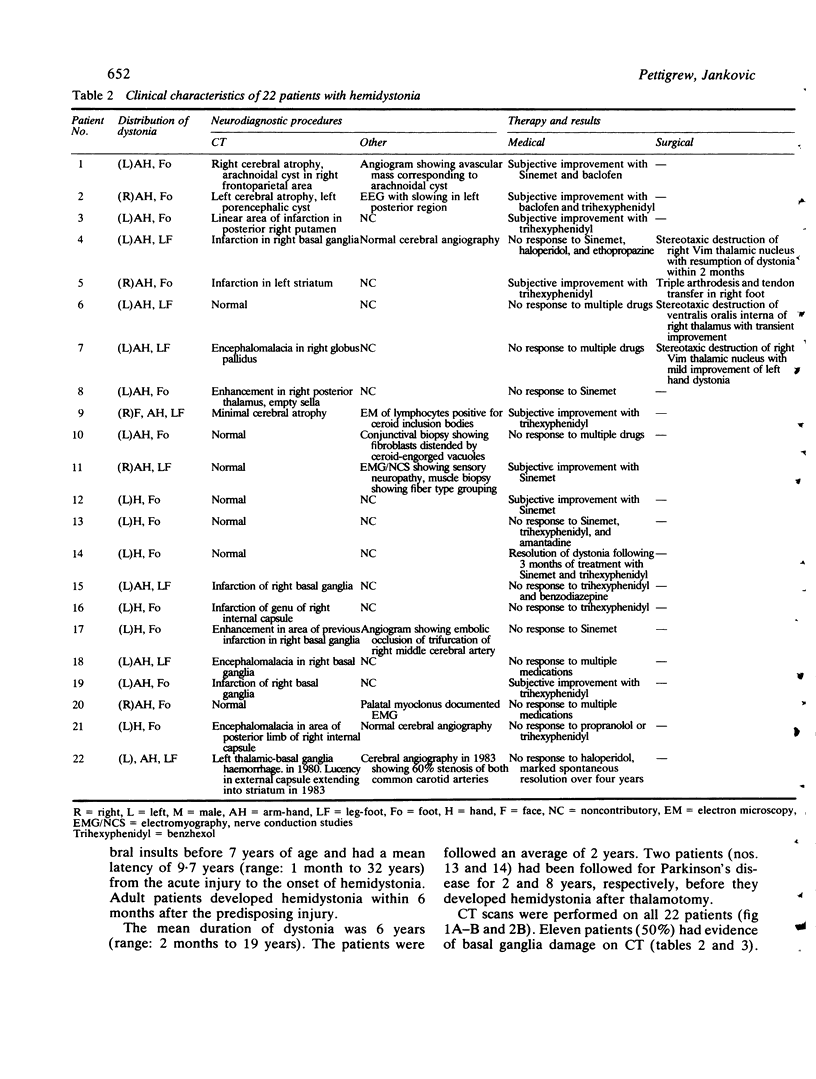
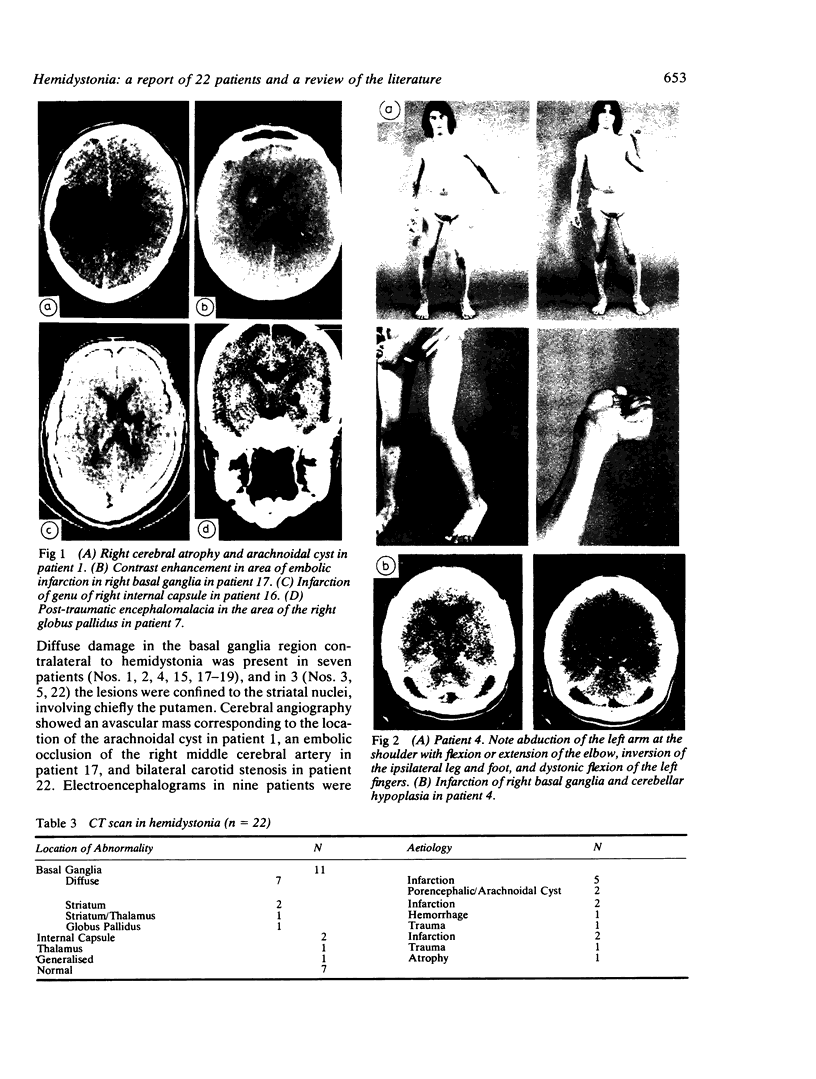
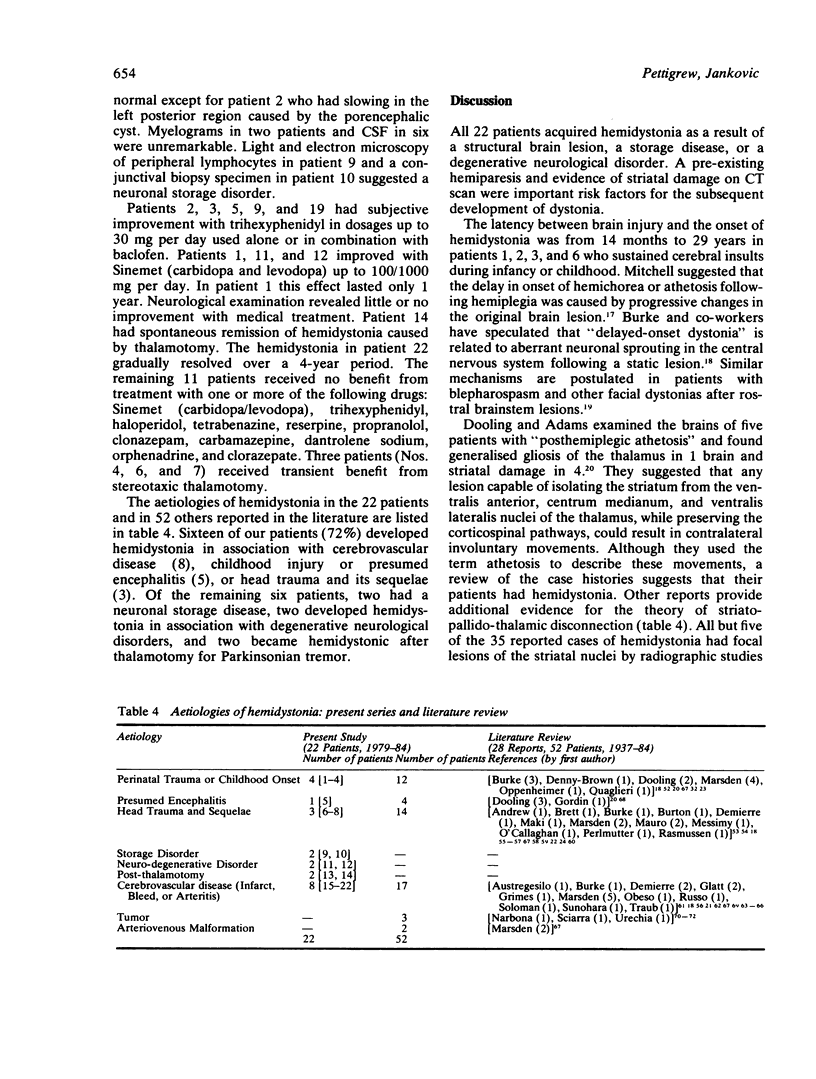
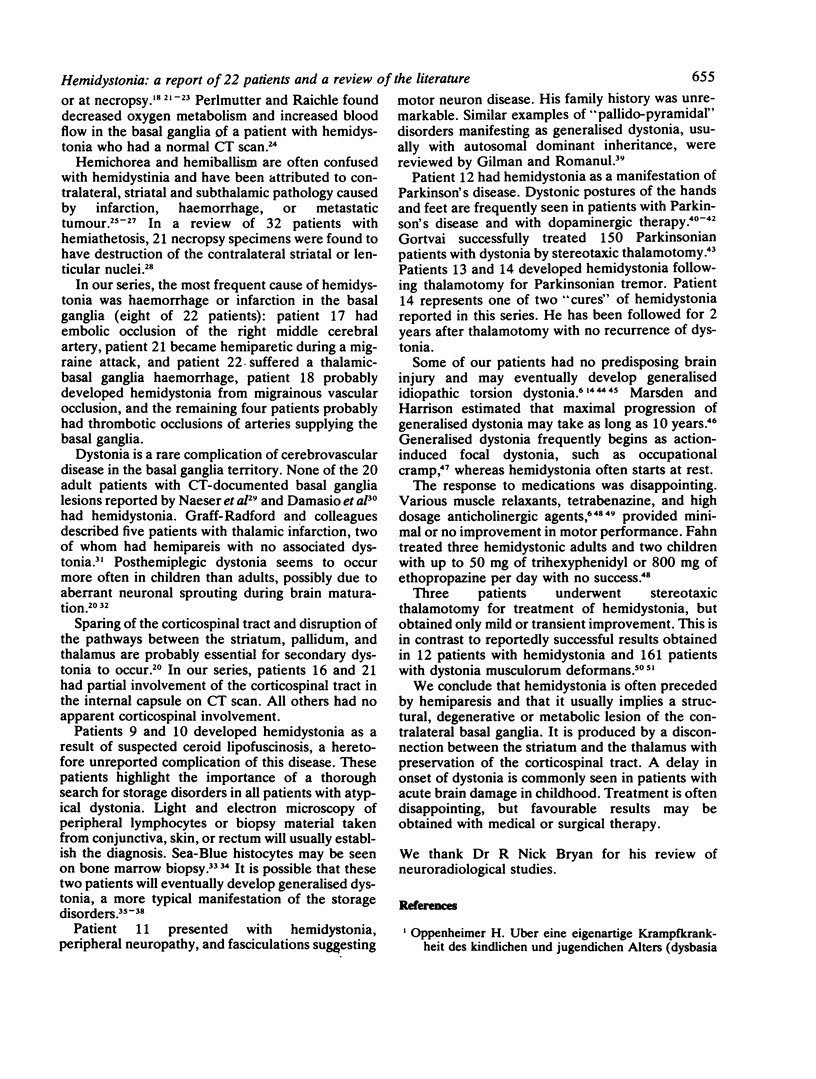
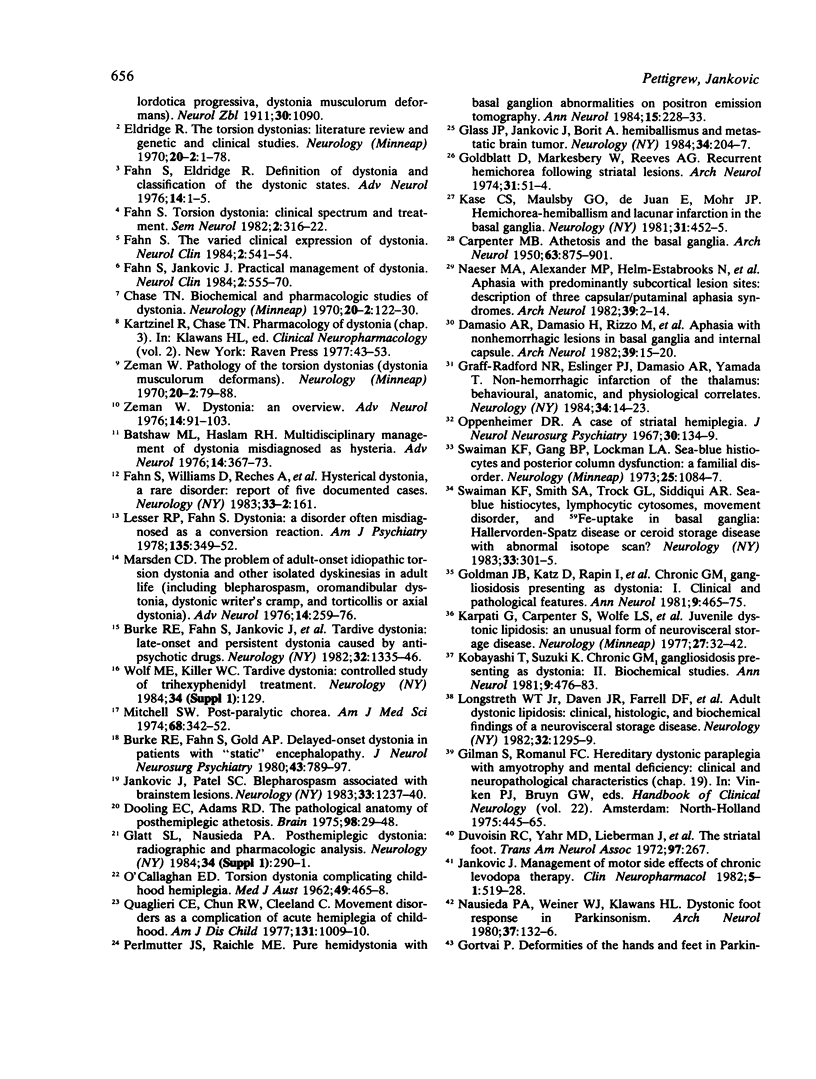

Images in this article
Selected References
These references are in PubMed. This may not be the complete list of references from this article.
- Andrew J., Fowler C. J., Harrison M. J. Stereotaxic thalamotomy in 55 cases of dystonia. Brain. 1983 Dec;106(Pt 4):981–1000. doi: 10.1093/brain/106.4.981. [DOI] [PubMed] [Google Scholar]
- Andrew J., Fowler C., Harrison M. J. Hemi-dystonia due to focal basal ganglia lesion after head injury and improved by stereotaxic thalamotomy. J Neurol Neurosurg Psychiatry. 1982 Mar;45(3):276–276. doi: 10.1136/jnnp.45.3.276. [DOI] [PMC free article] [PubMed] [Google Scholar]
- Batshaw M. L., Haslam R. H. Multidisciplinary management of dystonia misdiagnosed as hysteria. Adv Neurol. 1976;14:367–373. [PubMed] [Google Scholar]
- Brett E. M., Hoare R. D. Progressive hemi-dystonia due to focal basal ganglia lesion after mild head trauma. J Neurol Neurosurg Psychiatry. 1981 May;44(5):460–460. doi: 10.1136/jnnp.44.5.460. [DOI] [PMC free article] [PubMed] [Google Scholar]
- Burke R. E., Fahn S., Gold A. P. Delayed-onset dystonia in patients with "static" encephalopathy. J Neurol Neurosurg Psychiatry. 1980 Sep;43(9):789–797. doi: 10.1136/jnnp.43.9.789. [DOI] [PMC free article] [PubMed] [Google Scholar]
- Burke R. E., Fahn S., Jankovic J., Marsden C. D., Lang A. E., Gollomp S., Ilson J. Tardive dystonia: late-onset and persistent dystonia caused by antipsychotic drugs. Neurology. 1982 Dec;32(12):1335–1346. doi: 10.1212/wnl.32.12.1335. [DOI] [PubMed] [Google Scholar]
- Burton K., Farrell K., Li D., Calne D. B. Lesions of the putamen and dystonia: CT and magnetic resonance imaging. Neurology. 1984 Jul;34(7):962–965. doi: 10.1212/wnl.34.7.962. [DOI] [PubMed] [Google Scholar]
- CARPENTER M. B. Athetosis and the basal ganglia; review of the literature and study of 42 cases. Arch Neurol Psychiatry. 1950 Jun;63(6):875–901. doi: 10.1001/archneurpsyc.1950.02310240034002. [DOI] [PubMed] [Google Scholar]
- Chase T. N. Biochemical and pharmacologic studies of dystonia. Neurology. 1970 Nov;20(11):122–130. doi: 10.1212/wnl.20.11_part_2.122. [DOI] [PubMed] [Google Scholar]
- Damasio A. R., Damasio H., Rizzo M., Varney N., Gersh F. Aphasia with nonhemorrhagic lesions in the basal ganglia and internal capsule. Arch Neurol. 1982 Jan;39(1):15–24. doi: 10.1001/archneur.1982.00510130017003. [DOI] [PubMed] [Google Scholar]
- Demierre B., Rondot P. Dystonia caused by putamino-capsulo-caudate vascular lesions. J Neurol Neurosurg Psychiatry. 1983 May;46(5):404–409. doi: 10.1136/jnnp.46.5.404. [DOI] [PMC free article] [PubMed] [Google Scholar]
- Dooling E. C., Adams R. D. The pathological anatomy of posthemiplegic athetosis. Brain. 1975 Mar;98(1):29–48. doi: 10.1093/brain/98.1.29. [DOI] [PubMed] [Google Scholar]
- Eldridge R. The torsion dystonias: literature review and genetic and clinical studies. Neurology. 1970 Nov;20(11):1–78. doi: 10.1212/wnl.20.11_part_2.1. [DOI] [PubMed] [Google Scholar]
- Fahn S., Eldridge R. Definition of dystonia and classification of the dystonic states. Adv Neurol. 1976;14:1–5. [PubMed] [Google Scholar]
- Fahn S. High dosage anticholinergic therapy in dystonia. Neurology. 1983 Oct;33(10):1255–1261. doi: 10.1212/wnl.33.10.1255. [DOI] [PubMed] [Google Scholar]
- Fahn S., Jankovic J. Practical management of dystonia. Neurol Clin. 1984 Aug;2(3):555–569. [PubMed] [Google Scholar]
- Fahn S. The varied clinical expressions of dystonia. Neurol Clin. 1984 Aug;2(3):541–554. [PubMed] [Google Scholar]
- GORTVAI P. Deformities of the hands and feet in Parkinsonism and their reversibility by operation. J Neurol Neurosurg Psychiatry. 1963 Feb;26:33–36. doi: 10.1136/jnnp.26.1.33. [DOI] [PMC free article] [PubMed] [Google Scholar]
- Glass J. P., Jankovic J., Borit A. Hemiballism and metastatic brain tumor. Neurology. 1984 Feb;34(2):204–207. doi: 10.1212/wnl.34.2.204. [DOI] [PubMed] [Google Scholar]
- Goldblatt D., Markesbery W., Reeves A. G. Recurrent hemichorea following striatal lesions. Arch Neurol. 1974 Jul;31(1):51–54. doi: 10.1001/archneur.1974.00490370077012. [DOI] [PubMed] [Google Scholar]
- Goldman J. E., Katz D., Rapin I., Purpura D. P., Suzuki K. Chronic GM1 gangliosidosis presenting as dystonia: I. Clinical and pathological features. Ann Neurol. 1981 May;9(5):465–475. doi: 10.1002/ana.410090509. [DOI] [PubMed] [Google Scholar]
- Graff-Radford N. R., Eslinger P. J., Damasio A. R., Yamada T. Nonhemorrhagic infarction of the thalamus: behavioral, anatomic, and physiologic correlates. Neurology. 1984 Jan;34(1):14–23. doi: 10.1212/wnl.34.1.14. [DOI] [PubMed] [Google Scholar]
- Grimes J. D., Hassan M. N., Quarrington A. M., D'Alton J. Delayed-onset posthemiplegic dystonia: CT demonstration of basal ganglia pathology. Neurology. 1982 Sep;32(9):1033–1035. doi: 10.1212/wnl.32.9.1033. [DOI] [PubMed] [Google Scholar]
- Jankovic J., Patel S. C. Blepharospasm associated with brainstem lesions. Neurology. 1983 Sep;33(9):1237–1240. doi: 10.1212/wnl.33.9.1237. [DOI] [PubMed] [Google Scholar]
- Karpati G., Carpenter S., Wolfe L. S., Andermann F. Juvenile dystonic lipidosis: an unusual form of neurovisceral storage disease. Neurology. 1977 Jan;27(1):32–42. doi: 10.1212/wnl.27.1.32. [DOI] [PubMed] [Google Scholar]
- Kase C. S., Maulsby G. O., deJuan E., Mohr J. P. Hemichorea-hemiballism and lacunar infarction in the basal ganglia. Neurology. 1981 Apr;31(4):452–455. doi: 10.1212/wnl.31.4.452. [DOI] [PubMed] [Google Scholar]
- Kobayashi T., Suzuki K. Chronic GM1 gangliosidosis presenting as dystonia: II. Biochemical studies. Ann Neurol. 1981 May;9(5):476–483. doi: 10.1002/ana.410090510. [DOI] [PubMed] [Google Scholar]
- Lesser R. P., Fahn S. Dystonia: a disorder often misdiagnosed as a conversion reaction. Am J Psychiatry. 1978 Mar;135(3):349–352. doi: 10.1176/ajp.135.3.349. [DOI] [PubMed] [Google Scholar]
- Longstreth W. T., Jr, Daven J. R., Farrell D. F., Bolen J. W., Bird T. D. Adult dystonic lipidosis: clinical, histologic, and biochemical findings of a neurovisceral storage disease. Neurology. 1982 Nov;32(11):1295–1299. doi: 10.1212/wnl.32.11.1295. [DOI] [PubMed] [Google Scholar]
- Maki Y., Akimoto H., Enomoto T. Injuries of basal ganglia following head trauma in children. Childs Brain. 1980;7(3):113–123. doi: 10.1159/000119936. [DOI] [PubMed] [Google Scholar]
- Marsden C. D., Harrison M. J., Bundey S. Natural history of idiopathic torsion dystonia. Adv Neurol. 1976;14:177–187. [PubMed] [Google Scholar]
- Marsden C. D., Harrison M. J. Idiopathic torsion dystonia (dystonia musculorum deformans). A review of forty-two patients. Brain. 1974 Dec;97(4):793–810. doi: 10.1093/brain/97.1.793. [DOI] [PubMed] [Google Scholar]
- Marsden C. D. The problem of adult-onset idiopathic torsion dystonia and other isolated dyskinesias in adult life (including blepharospasm, oromandibular dystonia, dystonic writer's cramp, and torticollis, or axial dystonia). Adv Neurol. 1976;14:259–276. [PubMed] [Google Scholar]
- Messimy R., Diebler C., Metzger J. Dystonie de torsion du membre supérieur gauche probablement consécutive a un traumatisme cranien. Calcification de la tête du noyau caudé droit découverte à l'examen tomodensitométrique. Rev Neurol (Paris) 1977 Mar;133(3):199–206. [PubMed] [Google Scholar]
- Naeser M. A., Alexander M. P., Helm-Estabrooks N., Levine H. L., Laughlin S. A., Geschwind N. Aphasia with predominantly subcortical lesion sites: description of three capsular/putaminal aphasia syndromes. Arch Neurol. 1982 Jan;39(1):2–14. doi: 10.1001/archneur.1982.00510130004002. [DOI] [PubMed] [Google Scholar]
- Narbona J., Obeso J. A., Tuñon T., Martinez-Lage J. M., Marsden C. D. Hemi-dystonia secondary to localised basal ganglia tumour. J Neurol Neurosurg Psychiatry. 1984 Jul;47(7):704–709. doi: 10.1136/jnnp.47.7.704. [DOI] [PMC free article] [PubMed] [Google Scholar]
- Nausieda P. A., Weiner W. J., Klawans H. L. Dystonic foot response of Parkinsonism. Arch Neurol. 1980 Mar;37(3):132–136. doi: 10.1001/archneur.1980.00500520030003. [DOI] [PubMed] [Google Scholar]
- Oppenheimer D. R. A case of striatal hemiplegia. J Neurol Neurosurg Psychiatry. 1967 Apr;30(2):134–139. doi: 10.1136/jnnp.30.2.134. [DOI] [PMC free article] [PubMed] [Google Scholar]
- Perlmutter J. S., Raichle M. E. Pure hemidystonia with basal ganglion abnormalities on positron emission tomography. Ann Neurol. 1984 Mar;15(3):228–233. doi: 10.1002/ana.410150303. [DOI] [PubMed] [Google Scholar]
- Quaglieri C. E., Chun R. W., Cleeland C. Movement disorders as a complication of acute hemiplegia of childhood. Am J Dis Child. 1977 Sep;131(9):1009–1010. doi: 10.1001/archpedi.1977.02120220075013. [DOI] [PubMed] [Google Scholar]
- SCIARRA D., SPROFKIN B. E. Symptoms and signs referable to the basal ganglia in brain tumor. AMA Arch Neurol Psychiatry. 1953 Apr;69(4):450–461. doi: 10.1001/archneurpsyc.1953.02320280038004. [DOI] [PubMed] [Google Scholar]
- Sheehy M. P., Marsden C. D. Writers' cramp-a focal dystonia. Brain. 1982 Sep;105(Pt 3):461–480. doi: 10.1093/brain/105.3.461. [DOI] [PubMed] [Google Scholar]
- Solomon G. E., Engel M., Hecht H. L., Rapoport A. R. Progressive dyskinesia due to internal cerebral vein thrombosis. Neurology. 1982 Jul;32(7):769–772. doi: 10.1212/wnl.32.7.769. [DOI] [PubMed] [Google Scholar]
- Sunohara N., Mukoyama M., Mano Y., Satoyoshi E. Action-induced rhythmic dystonia: an autopsy case. Neurology. 1984 Mar;34(3):321–327. doi: 10.1212/wnl.34.3.321. [DOI] [PubMed] [Google Scholar]
- Swaiman K. F., Garg B. P., Lockman L. A. Sea-blue histiocyte and posterior column dysfunction: a familial disorder. Neurology. 1975 Nov;25(11):1084–1087. doi: 10.1212/wnl.25.11.1084. [DOI] [PubMed] [Google Scholar]
- Swaiman K. F., Smith S. A., Trock G. L., Siddiqui A. R. Sea-blue histiocytes, lymphocytic cytosomes, movement disorder and 59Fe-uptake in basal ganglia: Hallervorden-Spatz disease or ceroid storage disease with abnormal isotope scan? Neurology. 1983 Mar;33(3):301–305. doi: 10.1212/wnl.33.3.301. [DOI] [PubMed] [Google Scholar]
- Traub M., Ridley A. Focal dystonia in association with cerebral infarction. J Neurol Neurosurg Psychiatry. 1982 Nov;45(11):1073–1074. doi: 10.1136/jnnp.45.11.1073. [DOI] [PMC free article] [PubMed] [Google Scholar]
- Zeman W. Dystonia: an overview. Adv Neurol. 1976;14:91–103. [PubMed] [Google Scholar]
- Zeman W. Pathology of the torsion dystonias (dystonia musculorum deformans). Neurology. 1970 Nov;20(11):79–88. doi: 10.1212/wnl.20.11_part_2.79. [DOI] [PubMed] [Google Scholar]



